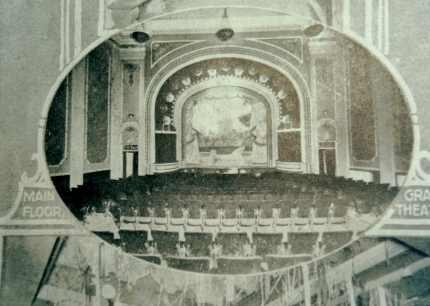


Grand Theatre
Bellingham, Washington
1224 Commercial St.
Organ installation timeframes:
Back to the Washington Original Theatre Installations page

Ed Ahern at the three-manual Kimball, after 1916
The first Grand Theater opened on March 27, 1905 at 127 West Holly Street. It was one of Bellingham's most popular vaudeville houses.
The Grand was owned by William Southern. Southern was born in Lancashire, England and was employed in coal mines for most of his younger years. He worked in several U.S. cities doing vaudeville before coming to Washington in 1904.
In 1912, the original theater was torn down to make way for the new J.J. Donovan Building that was built on the site. A new Grand Theater was erected at the same time, behind the Donovan Building, at 1224 Commercial Street. The 1910 Kimball was most likely moved to the new theatre. An entrance to the theater was maintained on Holly Street at roughly the location of the original Grand. The new Grand Theater featured motion pictures.

Grand Opening following remodel, c.1916

Grand Theatre auditorium, c.1916. Photo courtesy Jeff Fox.
Records show three different theatre organs associated with the Grand Theatre:
1910 - 2/8 Kimball tubular pneumatic. According to the OHS database, this instrument most likely moved to the new theatre when it was built in 1912. It eventually found its way to the First United Presbyterian church in Everett in 1929, but its whereabouts between 1916 and 1929 are unknown. Between 1953 and 1998, the instrument was installed in several other locations including a private residence and another church. Current status is unknown.
1916 - 3/ Kimball instrument. Cost was $18,000, disposition unknown. This instrument is not found in any of the opus lists or databases, but it is described in an article about the Grand Theatre's owner, William Southern. There is also a photograph of the three-manual console included above. According to Jeff Fox, chambers for the 1916 instrument were located above the proscenium in the ceiling of the theatre. According to those that heard it, when Ed Ahern would let go with full organ, the ceiling would actually shake and the light fixtures would have a bit of movement.
1927 - 2/3 Robert Morton. This instrument is found on the Junchen opus lists and robertmorton.org opus lists. For the robertmorton.org entry, a note is added: "mvd to Del Feely res; 1953 to Woodrow C. Wilson res, Seattle." Interestingly, Del Feely stated to Russ Evans that he at one time owned a 2/3 from the Grand, but that it was a Kimball rather than a Robert-Morton. According to Dell, the organ had a double roll player and he later transferred it to a party in Port Angeles. It's possible Del was mistaken about the instrument's original theatre home, or that is was a Kimball. The other possibility is that it really was a Kimball and that the Junchen and robertmorton.org opus lists are incorrect.
In the late 1920's, the Grand Theatre's Commercial St. entrance was converted to an exit and the long hallway exit on Holly St. became the new entrance. It is unknown if the original Grand Theatre vertical sign was moved to Holly Street or if a second, similar sign was added.
In 1931 the theatre's name was changed to OUR Theatre when Howard Hughes had it for a short time. The Wahl family (owners of Wahl's Department Store in the same building) took back the operation after Hughes pulled out. When Wahls enlarged their store in 1957, the long hallway entrance on Holly Street was incorporated into the store and the Commercial Street entrance was again used.
The last operator of the Grand was SRO and their lease lasted through December 31, 1973 with the showing of Last Tango in Paris.

Commercial Street, c.1928. Sign in box office reads: "Use Holly Street Entrance"
According to Jeff Fox of Bellingham, his great aunt Sylvia Brown played for some of the movies on the piano.

Street scene showing Holly Street entrance, c.1940's

Grand Theatre on left, c.1940s

Grand Theatre "Special Courtesy Pass," 1945. Courtesy Jeff Fox.

Holly Street May 1953, most likely during the annual Blossom Time Parade. Photo by Jack Carver, courtesy Whatcom Museum
According to Jeff Fox, the color inside the theatre just prior to demolition was a two-tone brown. "Compare this shot to the one taken in 1916. All back of the screen was bare concrete. I believe the original color of the theatre was cream, green, and gold but can not be certain. The chandeliers here are not that old but looked very nice. They were made of red plastic. All other plaster work in the theatre wss original, just painted over a few times."

Grand Theatre interior, 1973. Photo by Galen Biery. Courtesy Jeff Fox.

Grand Theatre, March 1974. Courtesy Jeff Fox.
The Grand Theatre met with the wrecking ball in July, 1974.



When the wide screen was installed, all plaster & second proscenium arch was stripped to bare cement and the stage was extended. According to Jeff Fox, the Echo division grill work could still be seen in the attic before demolition. July 1974.

Photos and historical facts, courtesy Jeffrey Fox 2000.

July 1974. The crane operator had just traded "The Ball" for "The Jaws" in the next episode of demolition. Photo courtesy Jeff Fox, 2014

July 1974. Photo courtesy Jeff Fox, 2014
In July 2016, parts from the 1910 Kimball showed up on the Craigslist site with location: Tacoma.

In corresponding with the seller, they provided the following information and photos:
"after it was moved to the Presbyterian church in Everett, it was given to Light of the Cross lutheran in (Bothell?) and installed by Bill Bunch and Wasserman. Th church had me remove it as it was a maintenance nightmare for them due to indiosyncrases of the 1910 Kimball chest design. I would highly recommend saving the toebaords rackboard and chest frame, but fitting them with a newere reliable unit action."


About this site © PSTOS, 1998-2025